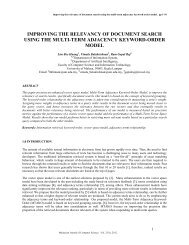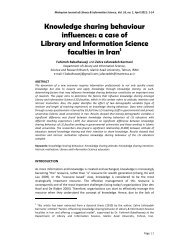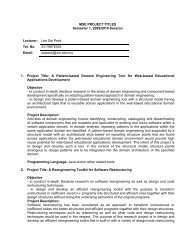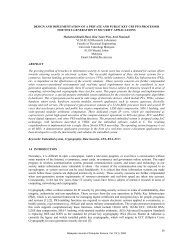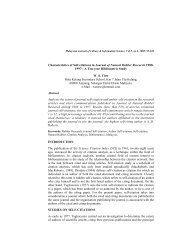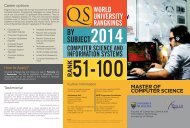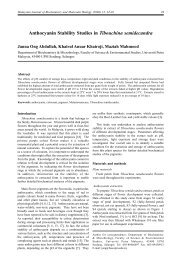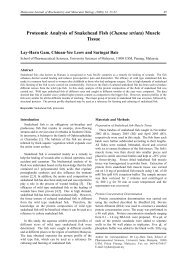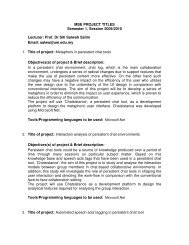Download1 - EJUM
Download1 - EJUM
Download1 - EJUM
Create successful ePaper yourself
Turn your PDF publications into a flip-book with our unique Google optimized e-Paper software.
Journal of Problem-Based Learning, Vol. 1, no.1, October 2003:19-39STUDENT ATTITUDE TOWARDS PROBLEM-BASED LEARNING INMANAGEMENT ACCOUNTINGABSTRACTTho, Lai Mooi (Susan); Ng, Kok Thye and Ahmad ZahiruddinFaculty of Business and AccountancyUniversity of Malaya, 50603 Kuala Lumpuremail: slmtho@um.edu.myThis paper examines students’ attitudes towards PBL, an instructional method used forthe first time in the accounting programme at the University of Malaya. The findingsshowed that in general students in the management accounting courses are positivetowards PBL. Though male students evaluated PBL more positively than female students,the differences are not statistically significant. On the whole, students who haveexperienced PBL in other courses, and those in the high academic ability group indicatedless favourable attitude towards PBL. Analysis of correlation between examinationperformance and attitude towards PBL yield weak results, though as a whole those whoare more positive towards PBL performed better. Though exploratory, the findings areexpected to provide inputs to fine tune the implementation of PBL at the Faculty andcontribute to the scarce Malaysian literature. More accounting educators will be exposedto this interactive and constructive approach which has become increasingly moreaccepted as a student centred teaching and learning instructional method. Finally, theresults support arguments for relatively more resources be allocated to problem basedlearning teaching approaches which are more labour intensive than the conventionallecture based method.Key words: Problem based learning, accounting, attitudes, and examination performanceINTRODUCTIONProblem based learning (PBL) has been given much attention in the education literatureduring the last fifteen years, particularly in the field of medical education. PBL,recognised as a progressive learner centred active educational approach, uses complex,real world problems as the starting point and focus on the learning process. Findings inresearch have indicated considerable support of benefits derived from using the PBLapproach over the conventional lecture based method (Schmidt, 1983; Patel, Greon andNorman, 1991; Kaufman and Mann, 1996).
Tho, L.M; Ng, K.T & Ahmad ZIn the last decades or so, accounting education has come under severe pressure to ensuregraduates possess attributes that are demanded by the market place. The desired attributesof an accounting graduate propagated by accounting professionals and academiciansinclude lifelong, self-directed learning, problem solving, team working, communicationand interpersonal skills (Sundem, Williams and Chironna, 1990; Lovell, 1992; Adler andMine, 1997; Hassall, Lewis and Broadbent, 1998). In an effort to address these issues, theproblem based instructional method has been implemented for the first time in theBachelor of Accounting programme at the University of Malaya in the 2002/2003session.The objectives of this exploratory study are fourfold as followes:(a) Firstly, we seek to report on the implementation of problem based learning in twomanagement accounting courses at the University of Malaya – an approachattempted for the first time in the teaching and learning of managementaccounting.(b) Secondly, the attitude of students towards PBL as implemented in managementaccounting is examined. Little is known about the attitude of students towards theuse of the PBL approach in the Malaysian context. Understanding studentattitude is needed to fine-tune the implementation of PBL in the accountingcourses and other courses at the faculty.(c) Thirdly, various factors which might influence students' attitude towards PBLsuch as gender, previous experience with PBL in other courses, academic abilityare investigated to provide greater understanding of student attitude towards thisnew approach. Little evidence on the impact of individual differences amongaccounting students on learning in the PBL instructional context has beendocumented. Examining the impact of student characteristics on the attitudetowards the PBL instructional method would shed light on whether moreattention should be accorded to aligning the PBL instructional method withcharacteristics of learners.(d) Fourthly, we seek to explore the relationship between student attitude towardsPBL and their examination performance. A study on instructional method andexamination performance reported that students who took accounting theory inthe class that applied the problem-based instructional method scored higherexamination marks than those who followed the lecture based method (Breton,1999).Findings are expected to provide inputs to fine tune the implementation of PBL at theFaculty and also contribute to share experience with other faculties at the University ofMalaya where PBL have just been implemented. By reporting on the implementation of20
Student Attitude Towards Problem-Based Learning in Management AccountingPBL, more instructors in accounting education will be aware of this interactive andconstructive approach. It supports the need to be more innovative in accounting educationand the need for experimentation with different teaching approaches and course designsto reach the desired educational goals.PROBLEM BASED INSTRUCTIONAL METHOD IN UMOver the last decade or so there has been mounting criticism of the inadequacies ofuniversity graduates in general by employers; criticisms include the lack ofcommunication, interpersonal, team working and problem solving skills. Questioning theadequacy of the conventional lecture-based methodology in producing graduates with therequired competencies, the University of Malaya in its effort to address these issuesengaged a university-wide drive to convince and train educators to adopt the PBLapproach.The problem based instructional method has been implemented on an experimental andmicro-level basis for the first time in the Bachelor of Accounting programme at theUniversity of Malaya in semester 1 and semester 2 of the 2002/2003 session in four 1courses out of a total of about 35 courses in the programme. Our study is based on the useof PBL in selected topics in two of the four courses using PBL. The lecturers of thesetwo courses have attended numerous seminars on PBL and a four-day intensive workshopon interactive learning and PBL conducted by consultants from Australia to prepare themfor PBL. The case material required are prepared by the course lecturers and all PBLactivities are also undertaken by them.We will describe in the following sections, our initial attempt at the partial application ofPBL in two of the three compulsory management courses. Appropriate adjustments aremade to the PBL process based on experience acquired after the first semester.(a) Problem-Based Learning in Management Accounting II.Out of seven topics in the course, two topics were selected to be taught under the PBLmode and the rest under the conventional lecture-based method. The topics selected forPBL were Advanced Variance Analysis and Inventory Management. These topics wereselected because they were considered by the lecturer as being appropriate for PBL andthey were the last two topics in the course, allowing more time for the PBL mode, as it ismore time consuming.1 The courses are Marketing, Taxation, Management Accounting 2 and Management Accounting 3.Marketing is fully taught under the PBL mode while taxation and the management accounting courses arepartially taught using PBL.21
Tho, L.M; Ng, K.T & Ahmad ZThe Implementation:Two batches of accounting undergraduates went through this course under the PBLmode: Batch 1 from Semester 1, and Batch 3 from Semester 2 of the 2002/2003 academicsession. The same PBL topics were taught for both the batches. While lectures wereconducted for the conventional lecture-based topics to the whole class of students takingthe course, no lectures were given for the two PBL topics. Instead the whole class of 210students (Batch 1) were divided into twenty small groups of about 10 students each and acase dealing with issues in the topic was distributed to each PBL group at the start of aPBL session (during the time allotted for course lectures 2 , two hours per lecture).Students were briefed on what they should do and given the following guidelines:Step 1: Look for unfamiliar words or terms in the scenario given.Step 2: Discuss in groups to clarify step 1.Discuss the issues in the problems.Allocation of tasks.Step 3: Search for material from valid sources to clarify step 1 and step 2.Step 4: Discuss in groups to solve the issues.Step 5: Prepare report.Normally, within the limited time given, students were only able to perform Step 1 andStep 2 under the supervision of a lecturer. Step 3 was carried out by the students withoutthe presence of the facilitator. Step 4 group discussions were held during two hoursallocated for tutorial sessions under the guidance of the lecturer. Each group was requiredto record that the steps above have been followed and also to write a proposed solution tothe problem in their own time. The official lecture and tutorial session could notaccommodate this. The facilitator was present throughout discussion sessions duringlecture and tutorial times.Basically, the same procedures were followed in the implementation of PBL for Batch 3.However, learning from the implementation in Batch 1 where many students did not takePBL group activities seriously as no marks were given for group activities, a total of 30marks carrying a weight of 30% of the total course marks were given to PBL groupactivities. This brought about encouraging results and Batch 3 students participatedseriously in group activities.2 Each course is made up of a total 14 sessions of four hours each; two hours for lecture and twohours for tutorial where students discussed assigned questions, problems or cases with thepresence of a tutor/lecturer in the conventional lecture-based method.22
Student Attitude Towards Problem-Based Learning in Management AccountingThe effectiveness of PBL activities was also compromised in Batch 1 as the large numberof groups (20 PBL groups) made it difficult for the lecturer to provide adequate guidanceas on the average each group was allocated only about five minutes of the lecturer's time.However, facilitation for Batch 3 was more effective as the number of students enrolledfor the course dropped to 94 resulting in ten PBL groups.The design of scenarios/cases follows the following process. For Batch 1, due to theconstraints of time and lack of experience, the scenarios were constructed based ontutorial questions. Suitable tutorial questions that dealt with important concepts andtheories were selected and modified in the content and wording. Problems used for Batch3 were further refined.(b) Problem-Based Learning in Management Accounting IIIThree topics selected in this course were conducted in the PBL mode. The topics wereFinancial Performance Measurement, Transfer Pricing and Capital Budgeting. Thesetopics were chosen because the lecturer considered these topics suitable for PBL.The Implementation:Two batches of accounting undergraduates have undergone this course under the PBLmode, that is, Batch 2 from semester 1 and Batch 4 from semester 2 of the 2002/2003academic session. Some of Batch 4 students have already experienced PBL inManagement Accounting II or other courses in semester 1.Cases were distributed a week in advance of group discussions. One hour was allotted foreach group discussion. The students were divided into groups of about ten students each.To avoid space and timing problems PBL group discussions were carried out during thetime allocated for tutorials. As such students of a tutorial group were divided into smallerPBL groups. For instance, a tutorial group of thirty students was divided into three PBLgroups. Since the tutorial time was two hours, two groups can have their discussionwithin this time. There is a need to find an extra hour and room for the third PBL group.This situation poses problems, as often rooms were not available at the times suitable orconvenient to students.In group discussions, students were expected to identify the problems or issues, discussways to rectify or solve the problems. The lecturer was present during group discussions,facilitated discussions and encouraged students to participate actively.After group discussions, the lecturer summarised the key issues of the PBL topic toensure that critical issues and concepts were adequately covered and understood by23
Tho, L.M; Ng, K.T & Ahmad Zstudents. This was considered by the lecturer as necessary in the transition to a studentcentredteaching methodology from a teacher-centred one, which students have beenexposed to throughout their academic life. In addition, conventional tutorial sessionswere conducted to further reinforce learning and application of the materials covered.The design of scenarios/cases is constructed by the lecturer to achieve the learningobjectives of the topics. The same cases were used in semester 2 after some modificationswere made to improve the scenarios.(c) Benefits and Difficulties of PBLAfter conducting PBL in two semesters to two different batches of students, the followingis a summary of observations made by the lecturers of the two management accountingcourses.Positive aspects of the PBL process include the following:• Students realised that they would not be 'spoon-fed', and that they were required tolook for information on their own.• Most students took part in group discussions after some coaxing, learned to expresstheir views and interact with others in their group.• Students indicated creativity in the search for information, learned to shareinformation and co-operate in their group.Some weaknesses and constraints observed by lecturers in the implementation of PBLinclude the following:• Lazy and disinterested students did not benefit from the PBL method, as they did notprepare beforehand.• The lecturer needed to spend much time constructing cases for discussion.• Many PBL groups under one facilitator in a semester made the facilitator's roleineffective and difficult as insufficient time and guidance can be given to each group.• Difficulty in obtaining extra rooms for group discussions hindered the smoothrunning of PBL group activities.The general consensus was that the partial implementation of PBL in these two courses isa right move despite the difficulties faced and the fact that lecturers have to do more thanin the traditional lecture based mode. Students will benefit not only in terms ofknowledge acquisition and its retention but also on other aspect of communication andpresentation skill, teamwork and getting to know members in the group better.24
Student Attitude Towards Problem-Based Learning in Management AccountingSTUDENTS’ ATTITUDES TOWARDS PBLAttitudes can generally be defined as learned predisposition to respond positively ornegatively to certain objects, situations, institutions, concepts or persons. Therefore,attitudes possess cognitive (beliefs, knowledge and expectations), affective (motivationaland emotional), and performance (behaviour or action) components (Aiken 1996). Astudent is said to exhibit positive attitude towards an instructional method if he or shelikes the method, enjoys learning with confidence and interest, feels no anxiety ortension, perceives the usefulness of the method and is motivated to spend more timelearning. A more positive attitude towards PBL is more likely to realise the claimedbenefits of the PBL instructional method. The issue of student attitude towards PBL willbe analysed in this study.Gender differences have been reported to impact on educational studies. Studies oncognitive learning styles of accounting students have provided some evidence that menand women have different learning styles (Lusk, 1973; Benbasat and Dexter, 1979;Jenkins and Holley, 1991; Tho and Veerinderjeet, 1998). The question of whether genderdifferences in learning style will influence their opinion of PBL will be investigated.It is theorised that previous experience with PBL in other courses would impact on theattitude of a student towards the use of PBL in management accounting courses. Havingundergone the methodology and being familiar with the requirements would impactpositively on students’ attitude towards PBL. The impact of experience in PBL in othercourses is reported in this paper.The PBL approach has recommended as a vehicle to engage lower achieving orchronically unmotivated students who often do not take advantage of traditionallecture/discussion learning situations (Delisle 1997; Glasgow 1997; Jones, Rasmussenand Moffitt, 1996). Hence this study examines in the accounting context whether lowerachieving students are more positively disposed towards PBL.Most research has been conducted on students in the medical field; generally researchfindings reported many benefits of the PBL approach compared to the conventionallecture based method (Schmidt and Moust, 1983; Boshuizen, Schmidt and Wassamer,1990; Patel, Greon and Norman, 1991; Albanese and Mitchell, 1993; Vernon and Blake,1993; Kaufman and Mann, 1996).In the field of accounting, findings from researches, though scarce, also indicate thesuperiority of the PBL method over the lecture-based method. Adler and Milne (1997) in25
Tho, L.M; Ng, K.T & Ahmad ZNew Zealand studied the views of management accounting students during their finalyear of undergraduate study in an accounting programme. Using a likert-type five pointscale questionnaire, they collected evidence of the effectiveness of course activities indeveloping students' knowledge, skills and attitudes considered desirable for accountingprofessionals and for them to be lifelong learners. Their results showed that increasingexposure to action-oriented learning tasks impact on the extent to which lifelong learningattributes are developed, and that in comparison to more traditionally taught courses,student exposure to action-oriented tasks in the management accounting course, impactson student perception of the extent to which lifelong learning attributes are developed.The Canadian study of Breton (1999) compared the impact of two accounting theorycourses, which used different teaching approach on the acquisition of knowledge andaptitude to deal with problems in a long-term perspective. One group of students attendeda course, which used the traditional lecture base method, and the other group of studentsattended the course based on a problem based learning method. His findings showedsignificant differences in the marks of the final examination of students of the twogroups. The group attending the course using the PBL approach scored higher marks tomost questions and also acquired better and longer lasting knowledge.METHODOLOGYA self-completed questionnaire was used to collect data on students’ attitude towardsPBL. The questionnaire contained 47 items stating positive and negative sentiments onvarious aspects related to PBL: the problems used in PBL (PROB), collaborative groupefforts (GROUP), the facilitation process by the tutor/lecturer (TUTOR), the PBL processitself (PROCESS), interest developed in PBL topics (INTEREST) and self-evaluation ofPBL benefits experienced (SELF-ASSESS). The statements describing these six keyaspects are jumbled up in the questionnaire and the number of statements for each aspectis not equal: PROB (7 statements), GROUP (9 statements), TUTOR (8 statements),PROCESS (11 statements), SELF-ASSESS (10 statements) and INTEREST (2statements). The questionnaire was pilot tested on ten students selected by the lecturers ofthe two management accounting courses in the first semester. The questionnaire wasadministered to all four batches of students in the study.Batches 1 to 4 were studied for the academic session 2002/2003. Batch 1 (total of 210students) and Batch 3 (total of 94 students) consisted of students taking ManagementAccounting II in semester one and two respectively. Batch 2 (total of 31 students) andBatch 4 (total of 107 students) students took Management Accounting III in semester oneand two respectively. The questionnaires were distributed during a class session to all26
Student Attitude Towards Problem-Based Learning in Management Accountingstudents in the batch by the lecturer of the course who explained the purpose and how tofill the questionnaire and assuring them of confidentiality of responses given.Respondents are required to fill in their student registration number, as their responseshave to be tallied with their examination performance in the PBL topics.The respondents were required to rate each item in the questionnaire on a 5-point scaleranging from '1' strongly agree to ‘5’ strongly disagree. The instrument demonstratedadequate reliability with Cronbach's alphas of 0.93 for Batch 1 and Batch 2, and 0.94 forBatch 3 and 0.92 for Batch 4.More detailed analysis on students' attitude towards PBL was conducted on whether therewere differences in gender responses, whether students' PBL experience in other coursesinfluenced their attitude towards PBL, and whether students' academic ability influencedtheir attitude towards PBL.Respondents were requested to indicate on the questionnaire they whether they had takenother courses conducted in the PBL mode. Academic ability is represented by thecumulative grade point average (CGPA) made up of all courses taken by the students inthe first academic year of the accounting programme. CGPA grades ranges from A to F;in the study, grades of A and B were considered 'high academic ability', and CGPAgrades of C, D, E and F were grouped into the 'low academic ability' group.T-tests were used to investigate differences of means between gender groups (male,female), experience in other PBL course groups (experience in other PBL courses, noexperience in other PBL courses), and academic ability groups (high academic ability,low academic ability). To test the correlation between examination performance andattitude towards PBL, the correlation coefficients were calculated. The marks obtained onquestions that examined the PBL topics in the semester final examination were used torepresent examination performance.RESULTS OF THE STUDYThe usable respondent percentages to the total number of students enrolled for the courseranges from 62% in Batch 3 to 90% in Batch 2 (Table 1). Some questionnaires were notcompleted properly and hence were not useable; out of a total of 330 received only 317completed questionnaires were usable. Table 1 also reports the group means of the sixaspects of PBL investigated, PROB, GROUP, TUTOR, PROCESS, INTEREST andSELF-ASSESS by the four batches of students. Pair wise comparisons of means betweenbatches were made using the Scheffe multiple comparison tests. The pair wisecomparison results (in parenthesis) revealing batches whose means differ were alsoshown in Table 1.27
Tho, L.M; Ng, K.T & Ahmad ZTable 1: Attitude Towards PBL: Overall Mean ScoresTotalStudentEnrolmentNo. of Resp.Response %Lecturer A Lecturer B Lecturer A Lecturer B MeanBatch 1 Batch 2 Batch 3 Batch 4 Scores F-value210 31 94 107 442n=148(70%)n=28(90%)n=58(62%)n=83(78%)N=317(72%)SELF- 3.19 (2,3,4) 2.83 (1) 2.70 (1) 2.75 (1) 2.87 18.93ASSESSGROUP 2.60 (3) 2.56 2.33 (1,4) 2.70 (3) 2.55 7.42PROB 2.79 (2,3,4) 2.48 (1) 2.51 (1) 2.55 (1) 2.58 9.25TUTOR 2.99 (2,3,4) 2.12 (1) 2.32 (1,4*) 2.06 (1,3*) 2.37 61.87PROCESS 2.91 (3,4) 2.76 2.61 (1) 2.60 (1) 2.72 15.75INTEREST 3.49 (2,3,4) 2.70 (1) 2.80 (1) 2.52 (1) 2.88 37.23Mean Scores 2.99 2.57 2.54 2.53 2.66Figures in parenthesis indicate the means of other batches which differ significantly from its mean atp
Tho, L.M; Ng, K.T & Ahmad ZTable 2 (continued): Student responses: Negative and Positive Statements on PBLSELF-ASSESS:Students' assessment of the benefits they have derived form PBL are only slightly positive and the highest agreement arerecorded for the following statements:1. "PBL has enabled me to think more critically".2. "Through participation in group discussions I have to some extent overcome my fear of speaking".The lowest agreement are recorded for the following statements:1. "I think more topics in this course should be conducted under PBL method".2. "I feel more confident preparing for PBL topics in my final examination".3. "I feel more confident preparing solutions for questions in tutorials of PBL topics than non-PBL topics".4. "I have less problems working out tutorial questions for PBL topics than non-PBL topics".5. "I have a deeper understanding of the issues of PBL topics than other topics".INTERESTBoth the statements under INTEREST are moderately favourable:1. "PBL mode of studying is more interesting than the conventional lecture method".2. "I have developed greater interest in topics discussed under PBL than topics under the lecture method".(b) Results According to BatchResponses of Batch 1 students differed significantly from those of the other three batchesas indicated by the Scheffe tests. The overall mean scores for Batch 1 was about neutralat 2.99 while that of Batches 2, 3 and 4 were slightly favourable at 2.57, 2.54 and 2.53(see Table 1). Students' evaluations of four (SELF-ASSESS, PROB, TUTOR,INTEREST) out of the six key aspects of PBL for Batch 1 were significantly worst thanthose of the other three batches. Students' views on PROCESS in Batch 1 are alsosignificantly worst than Batch 3 and Batch 4.In fact, Batch 1 respondents' views though somewhat favourable for GROUP (2.60) andPROB (2.79), were neutral for TUTOR (2.99) and PROCESS (2.91), and unfavourablefor SELF-ASSESS (3.19) and INTEREST (3.49).Several reasons could be attributed to the unfavourable views of Batch 1 students towardsPBL. Firstly, the large number of 210 students in Batch 1 as compared to the smallernumbers in Batch 2 (31 students), Batch 3 (94) and Batch 4 (107) has necessitatedstudents in Batch 1 to be divided into twenty PBL discussion groups. Lecturer A handledall the twenty groups alone. A key requirement of the effective implementation of PBL isthat the tutors or facilitators must be able to devote sufficient time and attention to PBLgroup discussions, hence enabling the facilitator to monitor closely the progress of thediscussions. In our case, Lecturer A, the only lecturer and tutor for Batch 1, divided hisattention among the twenty PBL groups.Secondly, time and resources constraints and the lack of experience in carrying out PBLfor the first time may have resulted in some teething problems. When Batch 3 responses30
Student Attitude Towards Problem-Based Learning in Management Accountingwere compared to those of Batch 1 (both batches undertaken by Lecturer A), markedimprovements in students' opinion were noted, as class size was reduced to 94, requiringLecturer A to facilitate only ten PBL groups. With experience gained after the somewhatchaotic initial PBL attempt in Batch 1, adjustments were made to the process, problemsand cases used. In fact, Lecturer A introduced assessment and instituted a merit/demeritsystem, allocating marks, which were counted towards the final examination score forgroup activities. As for Batch 2 and Batch 4 undertaken by Lecturer B, improvements instudents' attitude towards PBL were noted when Batch 4 responses were compared tothose of Batch 2.Student responses for Batch 2, Batch 3 and Batch 4 were more consistent and comparabledue to smaller batch sizes. Some differences in responses were noted between Batch 3and Batch 4 only. Batch 3 students gave more favourable responses (2.33) towardsGROUP than students of Batch 4 (2.70); the difference of means being statisticallysignificant at p
Tho, L.M; Ng, K.T & Ahmad ZTable 4: Batch Analysis: Gender, Experience in Other PBL Courses and Academic AbilityGender Experience in other PBLCoursesAcademic Ability(CGPA)Male Female Yes No High LowBATCH 1No. of Resp. n=40 n=108 n=52 N=96 n=76 n=72SELF-ASSESS 3.16 3.20 3.33 3.12 3.40 2.97GROUP 2.57 2.61 2.61 2.59 2.68 2.50PROB 2.81 2.79 2.88 2.74 2.91 2.66TUTOR 2.98 3.00 3.14** 2.91** 3.20** 2.77**PROCESS 2.85 2.93 2.95 2.88 3.01 2.79INTEREST 3.25 3.57 3.57 3.44 3.66* 3.30*BATCH 2No. of Resp. n=4 n=24 N=3 N=25 n=17 n=11SELF-ASSESS 2.62 2.86 2.97 2.81 2.86 2.77GROUP 2.58 2.55 2.63 2.55 2.68 2.36PROB 2.25 2.52 2.67 2.46 2.55* 2.39*TUTOR 1.97 2.15 2.34 2.10 2.14 2.09PROCESS 2.91 2.73 2.61 2.77 2.87 2.58INTEREST 2.25 2.77 3.17 2.64 2.73 2.64BATCH 3No. of Resp. n=3 n=55 n=17 n=41 n=11 n=47SELF-ASSESS 2.07 2.73 2.57 2.75 2.88 2.65GROUP 2.04 2.34 2.37** 2.31** 2.53 2.28PROB 2.38 2.52 2.43 2.54 2.56 2.50TUTOR 2.00 2.34 2.31 2.32 2.43 2.29PROCESS 2.70 2.60 2.56* 2.62* 2.79 2.56INTEREST 2.17 2.84 2.59** 2.89** 2.86* 2.79*BATCH 4No. of Resp. n=18 n=65 n=31 n=52 n=51 n=32SELF-ASSESS 2.49 2.83 2.95 2.64 2.76 2.74GROUP 2.52 2.74 2.79 2.64 2.73 2.65PROB 2.45** 2.58** 2.66 2.49 2.57 2.54TUTOR 2.07 2.07 2.13 2.03 2.06 2.07PROCESS 2.57 2.61 2.71 2.53 2.63 2.55INTEREST 2.28 2.59 2.66 2.44 2.59 2.42GenderFemale students made up almost 90% of the respondents to the questionnaire. Accordingto Table 3, the t-tests indicated there were no differences between the responses of male32
Student Attitude Towards Problem-Based Learning in Management Accountingand female students although male respondents appeared to be more positive about PBL.Referring to Table 4, there was statistically significant difference between gender groupsfor PROB for the respondents in Batch 4. Female respondents were less positive thantheir male counterparts about problems (PROB) used in the PBL process.Experience in Other PBL CoursesAccording to Table 3, students who experienced PBL in other courses were morenegative in attitude on all the six key aspects of PBL. However, the difference in opinionbetween students with experience in other PBL courses and those who did not, were notstatistically significant except with respect to their views on TUTOR. Respondents whodid not have experience in other PBL courses were more positive (mean score of 2.49)about facilitation by the tutors than those who had experience in other PBL courses(mean score of 2.68).This finding is contrary to expectation. According to Table 4, the overwhelming responseof batches 1, 2 and 4, was that those with no experience in other PBL courses were morepositive about PBL than those who had, though most of the differences between the twogroups were not statistically significant. Only Batch 3 respondents with experience inother PBL courses indicated more favourably attitude towards PBL than those who didnot. Statistically significant differences were noted with respect to their attitude towardsthe PBL process (PROCESS) and their interest (INTEREST). A check on the backgroundinformation of Batch 3 students indicated that many of them (13 out of 58 respondents)were repeaters of the Management Accounting II examination and hence had undergonethe problem based instructional method while they were in Batch 1. It was possible thatencountering the PBL method a second time had made them more confident of theprocess and method.Academic AbilityAccording to Table 3 the result showed that on the whole students with lower academicability were more favourably disposed towards PBL in all the six aspects. However,statistically significant differences were observed only with respect to GROUP andTUTOR. This finding appears to be consistent with the theory that PBL appeals more tolower achieving students who often are not motivated by traditional lecture method(Delisle, 1997; Glasgow, 1997).Referring to Table 4, the mean scores showed that lower academic ability groupconsistently gave more favourable scores towards the PBL instructional strategy in all thefour batches. However, most of the t-test results showed the differences between meanswere not statistically significant.33
Tho, L.M; Ng, K.T & Ahmad ZIt was also observed that higher academic ability students differ significantly in opinionfrom the lower academic ability students in Batch 1 and Batch 3; higher academic abilitystudents indicated that PBL method was not more interesting than the conventionallecture method. Good students in Batch 2 were also less positive towards problems usedthan their lower academic ability counterparts.Examination Performance and Attitude Towards PBLThe correlation between the key aspects of PBL and the student performance in the finalexamination questions on PBL topics according to batches are presented in Table 5. Inthis study, negative correlation coefficients indicate association between favourableattitude and high marks for the examination, and positive correlation coefficients indicateassociation between less favourable attitude and high marks for the examination.Table 5: Attitude Towards PBL and Examination Performance – Correlation CoefficientLecturer A Lecturer B Lecturer A Lecturer BBatch 1 Batch 2 Batch 3 Batch 4SELF-ASSESS 0.369** -0.001 -0.085 0.000GROUP 0.134 0.121 -0.079 0.161PROB 0.181** -0.137 -0.070 0.032TUTOR 0.304** -0.170 -0.164 -0.129PROCESS 0.246** 0.202 -0.060 0.005INTEREST 0.129 -0.246 -0.039 -0.043Overall 0.318** 0.002 -0.103 0.016** Correlation coefficients are statistically significantly at p
Student Attitude Towards Problem-Based Learning in Management AccountingWeak and insignificant association between examination performance and attitudetowards PBL were noted in Batch 2, 3, and 4, but many negative correlation coefficientswere observed, indicating that students who were more positive about PBL mode oflearning also achieved better examination results.It is not surprising that the results of this study show only a weak correlation betweenexamination performance and attitude towards PBL. Even in medical education wherePBL has been used for the past thirty years, research findings on the impact of PBL onexamination is scarce and the positive impact of PBL on examination results is notconvincing in spite of the large amount of resources allocated in PBL. Though Breton(1999) reported that accounting students taught under PBL performed better than thegroup taught under the conventional lecture method, collaborative evidence is stilllacking on this issue. Examination performance in reality is the impact of many complexfactors, and PBL is only one of the possible intervention factors.A major driving force in determining how students approach their learning is theassessment method used. There is no doubt that design of appropriate assessmentprocedures can motivate students to work harder in a PBL environment and ensure thatlearning is encouraged and rewarded. Our study faces the limitation of using theconventional measurement of performance - the results of the final written semesterexamination.SUMMARY AND CONCLUSIONThis paper examines students’ attitude towards PBL, an instructional method carried outfor the first time in the accounting programme at the University of Malaya. The findingsshowed that in general students are positive towards the PBL process in managementaccounting courses. Their most favourable evaluation is the excellent facilitation by thelecturers. Students do not indicate clearly that they have experienced the benefits of PBL.Furthermore, they do not find the PBL mode of studying much more interesting than thelecture based method.This not so positive attitude towards PBL is not surprising as throughout school anduniversity education so far, Malaysian students are exposed largely to the conventionallecture instructional method. A sudden change in instructional method is expected tocause disarray in the learning and teaching environment. It is possible there is resistanceon the part of the students to take responsibility for their own learning. Under theconventional lecture based system, many students presume that lecturers are responsible35
Tho, L.M; Ng, K.T & Ahmad Zfor their learning - lecturers select the content, present it and test whether it has 'stuck'rather than learners being responsible for their own learning (Gibbs 1992).The findings reveal that though male students evaluated PBL more positively than femalestudents, the differences are not statistically significant. On the whole students whoexperienced PBL in other courses and those who are in the high academic ability groupare less favourably disposed towards PBL. Plausibly the lack of understanding of PBL onthe part of the students and lack of expertise and experience on the part of facilitator mayhave brought about dissatisfaction with the programme. More attention and guidance bylecturers and tutors are ways to help students adjust in the transition from lecturer basedto student based self-directed learning.Though association between examination performance and attitude towards PBL is weakand insignificant, the results indicate that students who are more positive about PBLmode of learning also achieve better examination results. It may be important to reviewthe format of assessment in light of this new instructional method.The results of this study support the argument that relatively more resources should beallocated to courses using PBL as it is labour intensive; requiring small groupsfacilitation and continuous upgrading of learning materials to ensure its success.Finally, taking into account our inexperience with the PBL instructional method, thespeed with which PBL is implemented, and the almost total dependence on internalresources to develop our course material, the true benefits of PBL might not have beenfully uncovered by our study. Further research into PBL by other users would throw morelight on the usefulness and appropriateness of this instructional approach for educatingaccounting undergraduates.ACKNOWLEDGEMENTSIn preparing this paper, the authors gratefully acknowledge the assistance of both theanonymous referees.REFERENCESAdler, R.W., & Milne, M.J. (1997). Improving the quality of accounting students'learning through action oriented learning tasks. Accounting Education: aninternational journal, 6 (3): 191-215.36
Student Attitude Towards Problem-Based Learning in Management AccountingAiken, L.R. (1996). Rating scales and checklists: evaluating behaviour, personality andattitudes. Toronto John Wiley & Sons, Inc.Albanese, M.A., & Mitchell, S. (1993). Problem-based learning: a review of the literatureon its outcomes and implementation issues. Academic Medicine, 68 (1): 52-81.Benbasat, I., & Dexter, A.S. (1979). Value and Events Approaches to Accounting: AnExperimental Evaluation. The Accounting Review, 54: 735-749.Boshuizen, H.P.A., Schmidt, H.G., & Wassamer, I. (1990). Curriculum style and theintegration of biomedical and clinical knowledge. Paper presented at the 2 ndInternational Symposium on Problem Based Learning. Yokyakarta, Indonesia.Boud, D. (1985). Problem based Learning in education for the professions. Sydney:HERDSA.Boud, D., & Feletti, G.I. (1997). The challenge of problem based learning. 2 nd edition.London: Kogan Page.Breton, G. (1999). Some empirical evidence on the superiority of problem based learning(PBL) method. Accounting Education: an international journal, 8 (1): 1-12.Bridges, E.M., & Hallinger, P. (1992). Problem based learning for administrators.Eugene, Org.: ERIC Clearinghouse on Educational management, University ofOregon.Delisle, R. (1997). How to use problem based learning in the classroom. Alexandria, VA:Association for Supervision and Curriculum development.Engel, C.E. (1991). Not just a method but a way of learning. In D. Boud and G.I. Feletti(Eds), The challenge of problem based learning. London: Kogan Page.Gibbs, G. (1992). Improving the quality of students learning. Bristol: Technical andEducation Services Ltd.Gijselaers, W. H., Tempelaar, D.T., Keizer P.K., Blommeart, J.M., Bernard, E.M. andKasper, H. (Eds). 1995. Educational innovation in economics and businessadministration: the case of problem based learning. Norwell, Mass: Kluwer.37
Tho, L.M; Ng, K.T & Ahmad ZGlasgow, N. (1997). New curriculum for new times: A guide to student centred problembased learning. Thousand Oaks, CA: Corwin.Hassall, T., Lewis S., & Broadbent, J.M. (1998). The use and potential abuse of casestudies in accounting education, Accounting Education: an international journal, 7:37-47.Jenkins, E.K., & Holley, J.H. (1991). Learning style preferences and the prospectiveaccountant: are there gender differences? The Woman CPA, 53 (4): 46-49.Jones, B.F., Rasmussen, C.M., & Moffitt, M.C. (1996). Real life problem solving: acollaborative approach to interdisciplinary learning. Washington, DC: AmericanPsychological Association.Kaufan, D.M., & Mann, K.V. (1996). Comparing students’ attitudes in problem basedand conventional curricula. Academic Medicine, 71 (10): 1096-1099.Lovell, A. (1992). Accounting education: a developing debate. Management Accounting(CIMA), 70 (3): 20-23.Lusk, E. (1973). Cognitive Aspects of Annual Reports: Field Independence-dependence.Supplement to the Journal of Accounting Research, 191-202.Mergendoller, J.R., Maxwell, N.L., & Bellismo, Y. (2000). Comparing problem basedlearning and traditional instruction in high school economics. Journal of EducationalResearch, 93 (6): 374-382.Patel, V.L., Greon, G.J., & Norman, G.R. (1991). Effects of conventional and problembased medical curricula on problem solving. Academic Medicine, 66: 380-389.Saunders, P., & Gilliard, J. (1995). A framework for teaching basic economic concepts.New York: National Council for Economics Education.Schmidt, H.G. (1983). Problem based learning: rationale and description. MedicalEducation, 17 (1): 11-16.Schmidt, H.G., & Moust, J.H.C. (2000). Factors affecting small group tutorial learning: areview of research. In D.E. Evensen and C.E. Hmelo (Eds) Problem based learning: aresearch perspective on learning interactions: Mahwah, NJ: Lawrence Erlbaum, 19-52.38
Student Attitude Towards Problem-Based Learning in Management AccountingStephien, W., & Gallagher, S. (1993). Problem based learning: as authentic as it gets.Educational Leadership, 50 (7): 25-28.Sundem, G.L., Willliams, D.Z., & Chironna, J.E. (1990). The revolutions in accountingeducation. Management Accounting (IMA), 47 (12): 49-53.Vernon D.T., & Blake, R.L. (1993). Does problem based learning work? A meta-analysisof evaluative research. Academic Medicine, 68 (7): 550-563.Tho, L.M., Tay, A., & Veerinderjeet, S. (1998). Cognitive style, gender and accountingexamination performance. Accounting Journal.39



